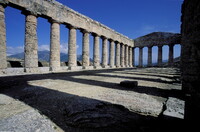Segesta: Doric Temple
unknown (Greek (ancient))

Download1A3-G-SG-TE-C1_cp.jpg (585.9Kb)
Date
-420--409Description
View within the temple, looking east from the southwest corner; Segesta is a town in western Sicily, about 17 km from Castellammare, that flourished 600-400 BCE. It was inhabited by the Elymi, a native people strongly influenced by Greek culture; Segesta came under Carthaginian rule in 409 BCE and then from ca. 260 BCE under Roman rule. The site is noted for its unfinished Doric temple (stylobate 23.17 x 58.07 m), which stands on a hill outside the city. The perfectly preserved exterior was almost completed, except for the fluting of the columns and the removal of the lifting-bosses; a cella and a roof were evidently planned. The four steps of the base (with strong curvature and remains of marks for its construction) and the colonnade with 6 by 14 columns and double angle contraction reflect the Early Classical Sicilian Doric style. The decorative details, however, and the proportional system of the elevations betray a knowledge of buildings constructed in Athens in 440-432 BCE under Pericles. The temple was the last of the Classical Doric temples in Sicily and was probably begun around 420 BCE and left unfinished at the outbreak of the Greco-Carthaginian war in 409 BCE. Source: Grove Art Online; http://www.groveart.com/ (accessed 2/3/2008)
Type of Work
temple; excavation (site)Subject
architectural exteriors, deities, mythology (Classical), Classical
Rights
Rights Statement
Licensed for educational and research use by the MIT community only